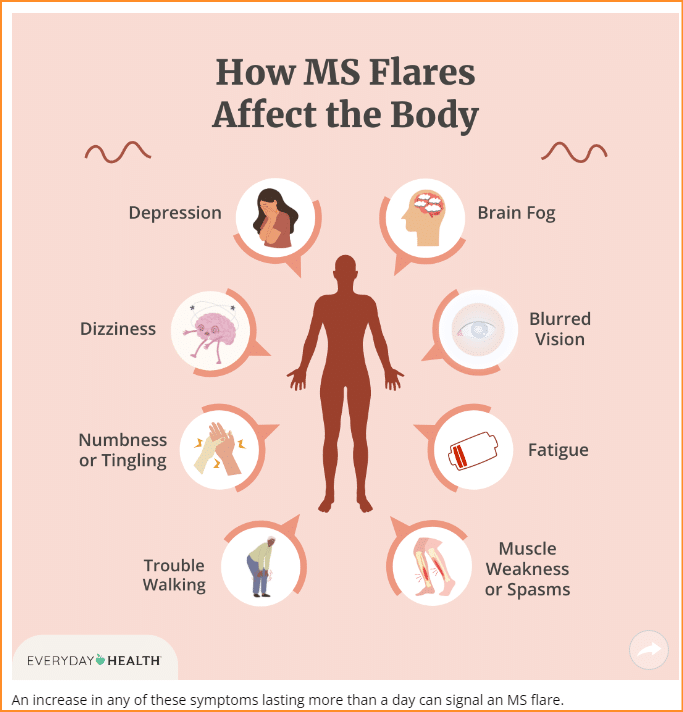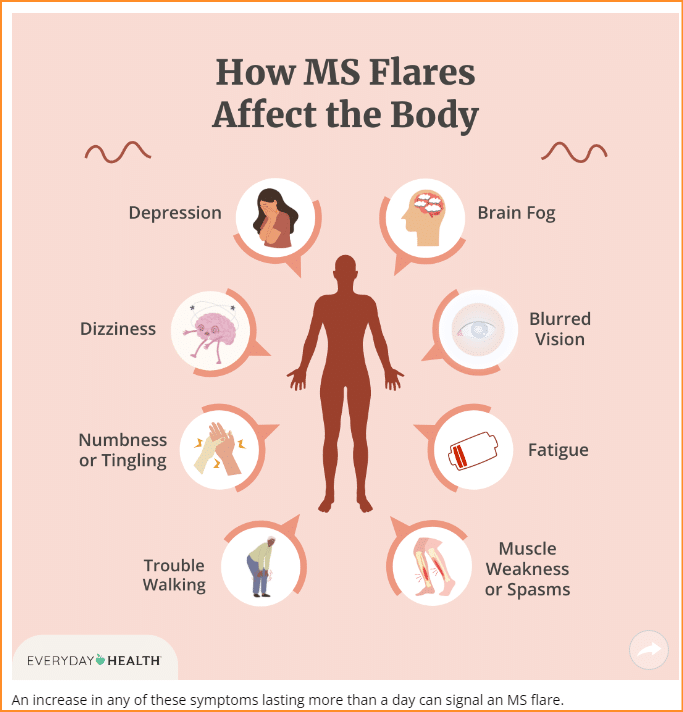
When new multiple sclerosis symptoms crop up or old ones worsen, you may be having an MS relapse.
By Chris Iliades, MD / Medically Reviewed by Jason Paul Chua, MD, PhD on November 22, 2022

About 85 percent of people who have multiple sclerosis are first diagnosed with relapsing-remitting MS (RRMS), according to the National Multiple Sclerosis Society (NMSS). This means they have relapses (also called flares, attacks, or exacerbations), or periods where symptoms get worse or new symptoms appear, and remissions, or periods when their symptoms are less severe or disappear.
Some people with secondary-progressive MS, a later stage of RRMS, continue to have relapses, along with a general progression of symptoms and disability.
Is It a Flare or a Pseudoexacerbation?
MS flares occur when inflammation in the central nervous system (brain and spinal cord) causes damage to the myelin sheath that protects the nerve fibers, as well as the underlying nerve fibers.
To be considered a true flare or exacerbation, a relapse must occur at least 30 days after the previous flare, and the new or recurring symptoms must last for at least 24 hours, per the NMSS.
When new or worsened MS symptoms clear up in less than 24 hours, it’s called a pseudo-relapse or pseudoexacerbation. Heat, humidity, overexertion, fatigue, fever, and infections (such as urinary tract infections) can cause pseudoexacerbations, notes the NMSS. Other illnesses, depression, and stress can also cause pseudoexacerbations, according to the Multiple Sclerosis Association of America (MSAA).
While the symptoms of a pseudoexacerbation are real, there is no new damage being done in the central nervous system.
True flares can last anywhere from a few days to a few weeks or months, per the NMSS.
It is not always clear from the outset whether a person is experiencing a flare or a pseudoexacerbation, and sometimes watching and waiting is the only way to know.
But if you experience any new symptom that interferes with your ability to function normally, says Matthew McCoyd, MD, a neurologist at Loyola University Medical Center in Chicago, let your doctor know about it right away.
Symptoms of a Flare
The signs and symptoms of an impending MS flare include virtually any of the possible symptoms caused by MS. They vary from person to person and from flare to flare.
True flares gradually worsen over the course of hours, consist of new “negative symptoms” or loss of function (weakness, vision loss, gait impairment, numbness), and will typically last multiple days. Symptoms that are brief and transient (lasting less than 24 hours) are not consistent with a flare.

Click here, to continue reading
——————————–
Stay informed with MS news and information - Sign-up here
For MS patients, caregivers or clinicians, Care to chat about MS? Join Our online COMMUNITY



